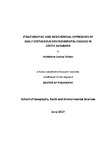Stratigraphic and Geochemical Expression of Early Cretaceous Environmental Change in Arctic Svalbard
| dc.contributor.supervisor | Price, Gregory | |
| dc.contributor.author | Vickers, Madeleine Larissa | |
| dc.contributor.other | School of Geography, Earth and Environmental Sciences | en_US |
| dc.date.accessioned | 2017-10-10T14:53:33Z | |
| dc.date.issued | 2017 | |
| dc.identifier | 10472477 | en_US |
| dc.identifier.uri | http://hdl.handle.net/10026.1/10041 | |
| dc.description.abstract |
The Arctic is climatically sensitive to global change and therefore climate records from this region are of key importance. Little, however, is known of the state of the Arctic in the traditionally “greenhouse” period of the Cretaceous. Climate conditions are often assumed to have been warm-temperate as evidenced by the presence of conifers and dinosaur trackways on Svalbard and other Arctic localities. However, isotopic evidence for cooling episodes, sequence stratigraphic evidence for interpreted glacio-eustatic sea-level falls, and the presence of more enigmatic deposits such as dropstones and glendonites has led to a re-evaluation of the question of climatic dynamism during the Cretaceous. This project evaluates the climatic and environmental character of Arctic Svalbard during the Early Cretaceous (palaeo-latitude of c. 65 °N), via a multiproxy sedimentological, geochemical, sequence- and chemo- stratigraphic study of Berriasian–Albian strata from the Central Basin of Svalbard. The “outsized clasts” recorded on Spitsbergen do not show evidence that they were rafted by glacial ice (e.g. surface striations), although could have been rafted by seasonal sea-ice. The results show that regionally widespread cold water conditions were the most likely control on ikaite formation and glendonite preservation. This counters recent studies that suggest a methane-seep driver for Mesozoic glendonites, and supports the global extent of Valanginian to Hauterivian and Late Aptian global cooling. Surface temperatures during cool episodes of < 14 °C, as implied by the presence of glendonites at the seafloor, are consistent with Polar (90 °N) temperatures being below freezing (even given reduced pole-to-equator temperature gradients). This study therefore supports the hypothesis that small polar ice-caps developed during the Valanginian – Hauterivian and Late Aptian cooling events. | en_US |
| dc.language.iso | en | |
| dc.publisher | University of Plymouth | |
| dc.subject | Stratigraphy | en_US |
| dc.subject | Palaeoclimate | en_US |
| dc.subject | Geochemistry | en_US |
| dc.subject | Sedimentology | en_US |
| dc.subject | Early Cretaceous | en_US |
| dc.subject.classification | PhD | en_US |
| dc.title | Stratigraphic and Geochemical Expression of Early Cretaceous Environmental Change in Arctic Svalbard | en_US |
| dc.type | Thesis | |
| plymouth.version | publishable | en_US |
| dc.identifier.doi | http://dx.doi.org/10.24382/923 | |
| dc.rights.embargodate | 2018-10-10T14:53:33Z | |
| dc.rights.embargoperiod | 12 months | en_US |
| dc.type.qualification | Doctorate | en_US |
| rioxxterms.version | NA |
Files in this item
This item appears in the following Collection(s)
-
01 Research Theses Main Collection
Research Theses Main


